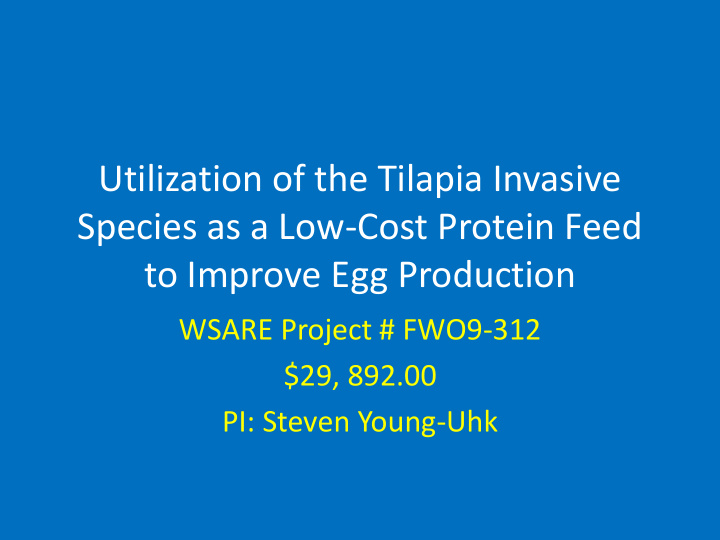



Utilization of the Tilapia Invasive Species as a Low-Cost Protein Feed to Improve Egg Production WSARE Project # FWO9-312 $29, 892.00 PI: Steven Young-Uhk
Introduction • Little improvement in egg production over the last 20 years • Wide range of issues but most prominent and consistent is feeding • Imported Chicken Feed is very expensive ($33-$44per 50 lb bag) • Limited number of small farmers • Need to develop a local feed that is cost-effective • Tilapia ( Oreochromis mossambicus ) is an invasive species- established in mangrove areas and freshwater holes and taro patches • Land crabs (Family Gecarcinidae) are also abundant. Often considered a pest since they consume plant materials causing extensive damages to field crops
Introduction • Feed mixture: tilapia, land crabs, and copra supplemented with green grass clippings • Target: family farms- less than 100 layers • Simple low-cost portable pens made from bamboo. Bedding materials – dry grass
Objectives/Targets • 1. Conduct feeding trials on laying chickens by using a local feed mixture consisting of tilapia, land • crab and copra. This is a comparative study of the local feed mixture against commercial layer feed, and a combination of both commercial feed and the local feed mixture. • 2. Identify sources and fishing methods for capturing tilapia in mangroves • 3. Develop educational materials and train farmers in simple feed production and processing using locally available materials.
Expected Outcomes • Adoption of new local feed for local egg production • Adoption of egg production system using simple portable pens • Improve egg production in Yap • Improve competition with imported eggs • Improve family/small farm resources • Help reduce tilapia invasion in the mangrove areas • Increase sustainable usage of land crabs and help maintain their population
Method • Three farmers to try out the new feed and compare against commercial feed • Raise chicks to 4.5 -5 months or start laying with chick starter/grower feed • Distribute to farmers • Three farmers to conduct the trials • Three farmers provide coconuts and catch tilapia and land crabs • Coconut grater
Method cont’d • Coconut milkd extractor – oil for local market • Meat grinder – tilapia and land crabs • Cook tilapia and land crabs and mix with grated coconut • Protein – two part tilapia & one part land crab • Outreach plan: brochure, COM-FSM website
Trials • Compare productivity of three different types of feed 1. Commercial layer feed 2. ½ commercial layer feed X ½ improved local feed 3. Improved local feed – mixture of tilapia, land crabs, and copra supplemented with grass cuttings
Ration Formulation Improved local feed: • 55% part tilapia X 40% crude protein =22 • 45% part land crab X 35% crude protein =15 37% CP • Mature coconut flesh, fresh 4% CP 14 37 18 4 19 33
Nutrient composition of coconut products Dignan, et al. 2004. The Pacific Islands Food Composition Tables. Food and Agriculture Organization. http://www.fao.org/docrep/007/y5432e/y5432e00.htm#Contents
Ration formulation cont’d • 14/33 = 42% 45% tilapia/land crab • 19/33 = 58% 55% coconut • Feeding: For 100 lbs, 55 lbs coconut, 23 lbs tilapia & 22 lbs land crab • Feeding: 3 lbs per 10 chickens per day • Green grass clippings – free choice
Caring for growing chicks
Growing chicks
Simple portable chicken house
Catching tilapia
Tilapia in mangroves
Tilapia in mangroves
Fishing for tilapia
Tilapia Harvest
Local Feed Making Tilapia Fresh Copra Land Crabs Ground tilapia-cooked Ground Copra Ground land crabs-cookecd 23% 55% 22%
Production system
Nesting Box
Electric Meat Grinder
Simple coconut extractor
Simple coconut extractor
Thank you!
Recommend
More recommend